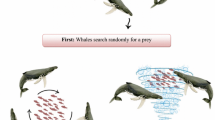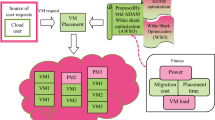Abstract
Data centres have seen significant growth recently as a result of the phenomenal rise of cloud computing. These data centres typically use more energy, which significantly raises operational costs. The management of server consolidation involves moving all Virtual Machines (VMs) to idle servers. However, performance suffers as a result of migration as migration volume and time increase. The Cloud computing model generates computational cooperative of huge computing services and systems. Recently, resource sharing, task scheduling and resource management between users are familiar research areas. In this paper, Fractional Improved Whale Social Optimization Algorithm (Fractional IWSOA) is developed for load balancing in the cloud model. The developed Fractional IWSOA is newly devised by incorporating Social Optimization Algorithm (SOA) and Improved Whale Optimization Algorithm (IWOA) along with Fractional Calculus (FC). Moreover, the categorization of VM is performed based on Deep Embedded Clustering (DEC) which is categorized into two types, underloaded VMs and overloaded VMs. Additionally, the tasks in underloaded VM is assigned based on various factors. As a result, the developed Fractional IWSOA performed better than other existing techniques in terms of load, capacity, and resource usage, which were respectively 0.1160, 0.5898, and 0.7168.








Similar content being viewed by others
References
Randles, M., Lamb, D. and Taleb-Bendiab, A. A comparative study into distributed load balancing algorithms for cloud computing. In Proceedings of 24th International Conference on Advanced Information Networking and Applications Workshops, IEEE, pp. 551–556, 2010.
M. S. Shaikh, C. Hua, M. A. Jatoi, M. M. Ansari and A. A. Qader, Application of grey wolf optimisation algorithm in parameter calculation of overhead transmission line system, IET Science, Measurement & Technology, Vol. 15, No. 2, pp. 218–231, 2021.
Al Nuaimi, K., Mohamed, N., Al Nuaimi, M. and Al-Jaroodi, J. A survey of load balancing in cloud computing: Challenges and algorithms. In Proceedings of Second Symposium on Network Cloud Computing and Applications, pp. 137–142, 2012.
Hu, J., Gu, J., Sun, G. and Zhao, T. A scheduling strategy on load balancing of virtual machine resources in cloud computing environment. In Proceedings of 3rd International Symposium on Parallel Architectures, Algorithms and Programming, pp. 89–96, 2010.
D. Manfredini, E. Stellini, A. Gracco, L. Lombardo, L. GuardaNardini and G. Siciliani, Orthodontics is temporomandibular disorder–neutral, The Angle Orthodontist, Vol. 86, No. 4, pp. 649–654, 2016.
M. A. Lopez, M. AndreasiBassi, L. Confalone, R. M. Gaudio, L. Lombardo and D. Lauritano, Clinical outcome of 215 transmucosal implants with a conical connection: A retrospective study after 5-year follow-up, Journal of Biological Regulators and Homeostatic Agents, Vol. 30, No. 2, pp. 55–60, 2016.
A. Thakur and M. S. Goraya, RAFL: A hybrid metaheuristic based resource allocation framework for load balancing in cloud computing environment, Simulation Modelling Practice and Theory, Vol. 16, pp. 102485, 2022.
M. Jarraya and S. Elloumi, Load balancing scheduling algorithms for virtual computing laboratories in a desktop-As-A-service cloud computing services, Computer Communications, Vol. 192, pp. 343–354, 2022.
Soni, G. and Kalra, M. A novel approach for load balancing in cloud data center. In Proceedings of IEEE International Advance Computing Conference, IEEE, pp. 807–812, 2014.
Asderah, D. and Kalkur, T.S. FEM based modeling of tunable BAW resonators with Ba0.8Sr0.2TiO3. In 2017 Joint IEEE International Symposium on the Applications of Ferroelectric (ISAF)/International Workshop on Acoustic Transduction Materials and Devices (IWATMD)/Piezoresponse Force Microscopy (PFM), pp. 15–18, 2017
Mario Di Mauro and Cesario Di Sarno, Improving SIEM capabilities through an enhanced probe for encrypted Skype traffic detection, Journal of Information Security and Applications, Vol. 38, pp. 85–95, 2018.
Di Mauro, M., Longo, M., Postiglione, F. and Tambasco, M. Availability Modeling and Evaluation of a Network Service Deployed via NFV, 2017.
D. A. Shafiq, N. Z. Jhanjhi and A. Abdullah, Load balancing techniques in cloud computing environment: A review, Journal of King Saud University—Computer and Information Sciences, Vol. 34, No. 7, pp. 3910–3933, 2022.
Velde, V., Enumala, K. and Bandi, K. Optimized adaptive load balancing algorithm in cloud computing. Materials Today: Proceedings, 2021.
M. S. Shaikh, C. Hua, M. A. Jatoi, M. M. Ansari and A. A. Qader, Parameter estimation of AC transmission line considering different bundle conductors using flux linkage technique, IEEE Canadian Journal of Electrical and Computer Engineering, Vol. 44, No. 3, pp. 313–320, 2021.
M. S. Shaikh, C. Hua, M. Hassan, S. Raj, M. A. Jatoi and M. M. Ansari, Optimal parameter estimation of overhead transmission line considering different bundle conductors with the uncertainty of load modeling, Optimal control applications and methods, Vol. 43, No. 3, pp. 652–666, 2022.
M. S. Shaikh, C. Hua, S. Raj, S. Kumar, M. Hassan, M. M. Ansari and M. A. Jatoi, Optimal parameter estimation of 1-phase and 3-phase transmission line for various bundle conductor’s using modified whale optimization algorithm, International Journal of Electrical Power & Energy Systems, Vol. 138, pp. 107893, 2022.
M. Ansari, C. Guo, S. S. Muhammad, N. Chopra, I. Haq and L. Shen, Planning for distribution system with grey wolf optimization method, Journal of Electrical Engineering & Technology, Vol. 15, No. 5, pp. 1485–1499, 2020.
M. M. Ansari, C. Guo, M. Shaikh, N. Chopra, B. Yang, J. Pan, Y. Zhu and X. Huang, Considering the uncertainty of hydrothermal wind and solar-based DG, Alexandria Engineering Journal, Vol. 59, No. 6, pp. 4211–4236, 2020.
D. B. LD and P. V. Krishna, Honey bee behavior inspired load balancing of tasks in cloud computing environments, Applied Soft Computing, Vol. 13, No. 5, pp. 2292–2303, 2013.
Li, J., Lei, H., Alavi, A.H. and Wang, G-G. Elephant herding optimization: Variants, hybrids, and applications. MDPI, vol.8, no.9, 2020.
Paliwal, N., Srivastava L. and Pandit, M. Application of grey wolf optimization algorithm for load frequency control in multi-source single area power system. Evolutionary Intelligence, 2020.
Li, K., Xu, G., Zhao, G., Dong, Y. and Wang, D. Cloud task scheduling based on load balancing ant colony optimization. In Proceedings of Sixth Annual Chinagrid Conference, pp. 3–9, 2011.
Chen, H., Wang, F., Helian, N. and Akanmu, G. User-priority guided Min-Min scheduling algorithm for load balancing in cloud computing. In 2013 National Conference on Parallel Computing Technologies, IEEE, pp. 1–8, 2013.
M. Hassan, Dynamic modeling and vector control of AC induction traction motor in china railway, Sukkur IBA Journal of Emerging Technologies, Vol. 3, No. 2, pp. 1111–1133, 2020.
M. Hassan, X. Ge, R. Atif, A. Teklu, M. Mastoi and M. Shahid, Computational efficient model predictive current control for interior permanent magnet synchronous motor drives, IET Power Electronics, Vol. 15, pp. 1–23, 2022.
Panwar, R. and Mallick, B. Load balancing in cloud computing using dynamic load management algorithm. In Proceedings of IEEE International Conference on Green Computing and Internet of Things, pp. 773–778, 2015.
C. Ashok Kumar and R. Vimala, Load balancing in cloud environment exploiting hybridization of chicken swarm and enhanced Raven Roosting optimization algorithm, Multimedia Research, Vol. 3, No. 1, pp. 45–55, 2020.
V. K. Netaji and G. P. Bhole, Optimal container resource allocation using hybrid SA-MFO algorithm in cloud architecture, Multimedia Research, Vol. 3, No. 1, pp. 11–20, 2020.
M. K. Michael, Workflow scheduling using improved moth swarm optimization algorithm in cloud computing", Multimedia Research, Vol. 3, No. 3, pp. 36–43, 2020.
S. Xue, M. Li, X. Xu, J. Chen and S. Xue, An ACO-LB algorithm for task scheduling in the cloud environment, Journal of Software, Vol. 9, No. 2, pp. 466–473, 2014.
Q. Guo, Task scheduling based on ant colony optimization in cloud environment, In Proceedings of AIP Conference Proceedings, Vol. 1834, No. 1, pp. 040039, 2017.
Jiarui Wang, Grey Wolf Optimization and Crow Search Algorithm for Resource Allocation Scheme in Cloud Computing, Multimedia Research, Vol. 4, No. 3, pp. 17–14, 2021.
Guo, X., Gao, L., Liu, X. and Yin, J. Improved deep embedded clustering with local structure preservation. In Ijcai, pp.1753–1759, August 2017.
N. Karimi and K. Khandani, Social optimization algorithm with application to economic dispatch problem, International Transactions on Electrical Energy Systems, Vol. 30, No. 11, pp. e12593, 2020.
G.-Y. Ning and D.-Q. Cao, Improved whale optimization algorithm for solving constrained optimization problems, Discrete Dynamics in Nature and Society, 2021. https://doi.org/10.1155/2021/8832251.
P. R. Bhaladhare and D. C. Jinwala, A clustering approach for the-diversity model in privacy preserving data mining using fractional calculus-bacterial foraging optimization algorithm, Advances in Computer Engineering, 2014. https://doi.org/10.1155/2014/396529.
C. A. Kumar and R. Vimala, C-FDLA: Crow search with integrated fractional dragonfly algorithm for load balancing in cloud computing environments, Journal of Circuits, Systems and Computers, Vol. 28, No. 07, pp. 1950115, 2019.
N. Thilagavathi, D. D. Dharani, R. Sasilekha, V. Suruliandi and V. R. Uthariaraj, Energy efficient load balancing in cloud data center using clustering technique, International Journal of Intelligent Information Technologies (IJIIT), Vol. 15, No. 1, pp. 84–100, 2019.
S. Mohanty, P. K. Patra, M. Ray and S. Mohapatra, A novel meta-heuristic approach for load balancing in cloud computing. In Research Anthology on Architectures, Frameworks, and Integration Strategies for Distributed and Cloud Computing, pp. 504–526, IGI Global, 2021.
A. Hussain, M. Aleem, M. A. Iqbal and M. A. Islam, SLA-RALBA: cost-efficient and resource-aware load balancing algorithm for cloud computing, The Journal of Supercomputing, Vol. 75, pp. 1–27, 2019.
W. Huang, Z. Ma, X. Dai, M. Xu and Y. Gao, Fuzzy clustering with feature weight preferences for load balancing in cloud, International Journal of Software Engineering and Knowledge Engineering, Vol. 28, No. 5, pp. 593–617, 2018.
J. P. B. Mapetu, L. Kong and Z. Chen, A dynamic VM consolidation approach based on load balancing using Pearson correlation in cloud computing, The Journal of Supercomputing, Vol. 77, No. 6, pp. 5840–5881, 2021.
A. Pourghaffari, M. Barari and S. SedighianKashi, An efficient method for allocating resources in a cloud computing environment with a load balancing approach, Concurrency and Computation Practice and Experience, Vol. 31, No. 17, pp. e5285, 2019.
V. Priya, C. S. Kumar and R. Kannan, Resource scheduling algorithm with load balancing for cloud service provisioning, Applied Soft Computing, Vol. 76, pp. 416–424, 2019.
X. Xiong, X. Hu and H. Guo, A hybrid optimized grey seasonal variation index model improved by whale optimization algorithm for forecasting the residential electricity consumption, Energy, Vol. 234, pp. 121127, 2021.
Author information
Authors and Affiliations
Corresponding author
Additional information
Publisher's Note
Springer Nature remains neutral with regard to jurisdictional claims in published maps and institutional affiliations.
Rights and permissions
About this article
Cite this article
George, S.S., Pramila, R.S. Fractional IWSOA-LB: Fractional Improved Whale Social Optimization Based VM Migration Strategy for Load Balancing in Cloud Computing. Int J Wireless Inf Networks 30, 58–74 (2023). https://doi.org/10.1007/s10776-023-00591-0
Received:
Revised:
Accepted:
Published:
Issue Date:
DOI: https://doi.org/10.1007/s10776-023-00591-0




